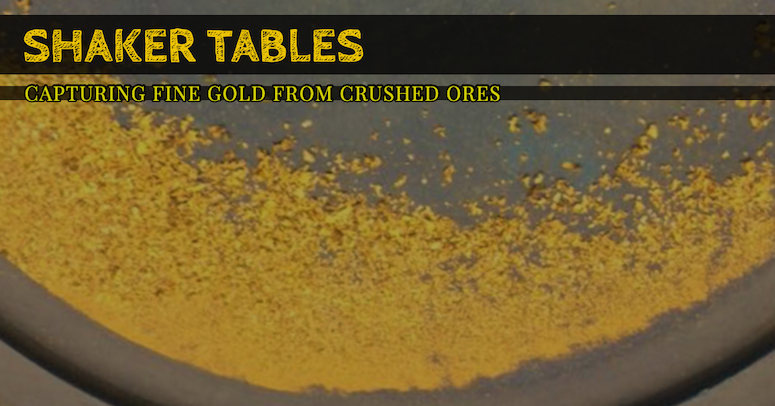
A shaker table is specialized equipment that operates on the gravity principle just like most other gold separators. When properly adjusted, it is able to separate the composites of the concentrates according to their weight and size.
This highly efficient separation is made possible through the major components of the machine such as the deck that is covered with structures of riffles, which run perpendicular to the feed point off the table. These riffles are similar to a sluice box except much smaller. When properly adjusted, these concentrator tables are able to capture even the tiniest specks of gold. Many commercial operations use them for their final recovery.
Shaker Table Power & Setup
Shaker tables can be powered by any means necessary, generally depending on the power sources available at the processing site. It can be powered using a generator or any other source of power able to make the machine vibrate back and forth. Smaller vibrating tables used by small-scale miners can easily be setup to run off a car battery.
When the table is completely positioned, there is also a provision for water supply. The water must be kept clean as it helps with the washing of the concentrates when they are fed onto the machine. When separating gold from the concentrates of gravel or crushed ore, the concentrate is fed to the machine through the feeder box.
When the gravel or crushed ore concentrate is fed onto the machine on one end of the table with the feeder box positioned a bit higher from the deck, the water running over the concentrate in the feeder box allow it to flow freely as slurry onto the surface of the table through a trough as the machine is vibrating.

Separation of Gold Particles
Meanwhile, as the concentrate gets on the surface of the table water must be kept running across the content. It is at this point that the less dense material or tailings will wash away to the sides of the table, while leaving the heavier content like gold, which then proceeds to the collection points on the far end of the table with the movements propagated by the vibrations of the table as it moves through several tapered strips known as riffles or grooves.
The far end of the table has the collection points set up for the gold which has been separated from the wastes as well as separate collection points for the wastes, and this makes the extraction of gold much easier irrespective of the size.
As the table vibrates it causes the content that is light and extremely fine to be washed over the riffles making them to move along the riffles through the reciprocating kind of motion of the deck. Gold collection is made much easier because the denser content is held back.
When the separation process is done, the heavier concentrates are discharged on the far end of the deck. And the unwanted concentrates are gotten rid of through the lower edge.
Also Read: Selling Placer Gold to a Refinery
Fine Tuning for Optimal Recovery of Gold
It is also important to note that, when using the shaker table, it is critically important how much water and vibration you introduce to the content being monitored. This means that, when inadequate water is supplied, there will be less washing off of the unwanted material. As a result, some gold might not be extracted.
In the same way, adding too much water during the washing process might cause even the gold that was supposed to be recovered to get lost. Therefore, operators must always know the right amount of water to provide, as well as the intensity of the vibrations per time.
If proper directions are not followed it will be very difficult to extract gold, especially the super fine type of gold where shaker tables are designed for. Just as with any type of specialized mining equipment, it is critical that you read the manual, adjust and continuously experiment with different settings for optimal recovery!

Are Shaker Tables Right for Everyone?
When it comes to final gold recovery and separation, there are many different options for the miners. Every operation is different and the best equipment will vary depending on your operation.
I have met professional gold miners who have had poor results using shaker tables for their gold, simply because the type of gold (flat, thin placer bits) were difficult to hold and retain. At another site where to nature of the gold was coarse and crushed from quartz ore, the shaker was the perfect tool and provided excellent capture rates.
Good shaker tables are expensive. There are smaller ones available for small operations that only cost a few hundred dollars. For larger operations, you can expect to spend several thousand dollars, and lots of time experimenting to get proper recovery.
Next: The Rocker Box – Mining Gear of the Early American Goldfields
Also Read: Remove Black Sands – Final Gold Recovery with the Blue Bowl Concentrator
